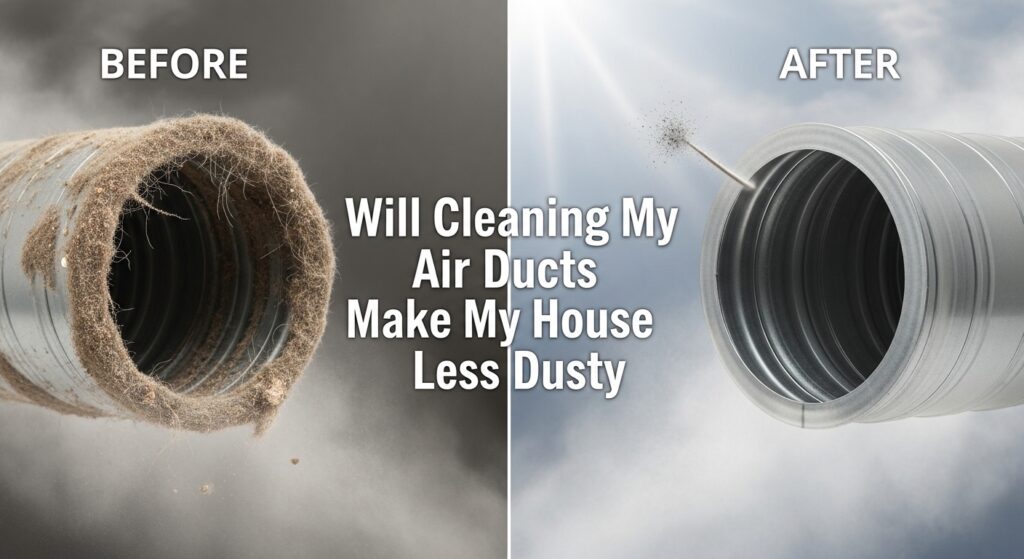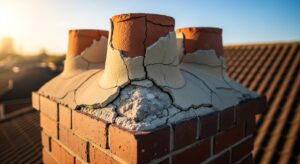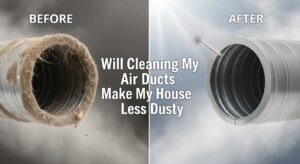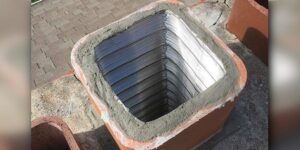You’ve been dusting for what seems like days on end, yet somehow, your coffee table is still dusty. How does that even happen? And it’s not like you haven’t tried— you’ve squeezed in extra vacuum sessions, changed the air filters, and even bought one of those expensive air purifiers. Yet, nothing seems to work. So when an air duct cleaning company calls, promising to solve your dust problems by cleaning your HVAC system, it’s tempting to believe them.
Will cleaning your ducts reduce dust? Maybe.
Will it solve your dust problem? Probably not the way you’re hoping.
Let’s dig into what science actually says about household dust, what role your ductwork plays, and whether air duct cleaning in Teaneck is really the solution you’ve been looking for
What the EPA Says About Duct Cleaning and Dust
The Environmental Protection Agency states clearly that there are no studies that conclusively demonstrate that particle levels in homes increase because of dirty air ducts or go down after cleaning.
That’s because much of the dirt that may accumulate inside air ducts adheres to duct surfaces and doesn’t necessarily enter the living space.
So, while the EPA isn’t saying duct cleaning is bad or useless, they’re saying there’s no solid scientific evidence that it significantly reduces dust levels in your home.
This might surprise you, especially if you’ve been told that dirty ducts are constantly pumping dust into your living space. The reality is that dust accumulation in ducts tends to stick to surfaces rather than becoming airborne and circulating through your home.
However, the EPA does acknowledge that there are specific situations where duct cleaning makes sense for health reasons:
- When there’s substantial visible mold growth inside ducts
- When ducts are infested with vermin
- When ducts are clogged with excessive amounts of dust and debris that are actually being released into the home
What Makes Up Household Dust?
We’ll hold you up for just a bit longer before we can get to the conclusive answer. After all, it’s important to understand what household dust actually is and where it comes from.
According to scientific research, dust in homes is composed of dead skin cells, plant pollen, human hair, animal fur, textile fibers, paper fibers, minerals from outdoor soil, burnt meteorite particles, and many other materials. Sounds pretty gross, but it is what it is.
The key point here is that most household dust is generated by normal living activities inside your home. Every time you walk across carpet, sit on upholstered furniture, handle paper, cook food, or simply exist in your space, you’re creating dust.
Here’s where we bust some myths. Your HVAC system isn’t actually creating this dust. It’s designed to filter it out of your air.
So, When Do Dirty Ducts Actually Contribute to Dust Problems?
You now know that your HVAC typically doesn’t contribute to your household dust. But, there may be times when it does.
1. Leaky Ductwork
This is probably the biggest issue that contributes to dust problems. When your ductwork has holes, loose connections, or poor sealing, it can pull dusty air from unconditioned spaces and distribute it throughout your home.
2. Severely Contaminated Systems
The EPA recommends duct cleaning when ducts are clogged with excessive amounts of dust and debris, and particles are actually being released into the home from supply registers. If you can literally see dust blowing out of your vents when the system runs, that’s a clear indication that duct cleaning might help!
3. Construction Dust
If you’ve had construction or renovation work done, construction dust can accumulate in ductwork and continue circulating long after the project is finished.
4. Mold
HVAC systems and associated ductwork can be sources of mold. When you have contamination in your ducts, cleaning becomes important not just for dust control but for health reasons.
Read Out: Post-Construction Duct Cleaning Why It’s Critical for New Buildings
Effective Strategies for Dust Control
Dust seems to be taking over your home, furniture, and life. What now? The good news is that there are some effective ways to limit dust, if not eliminate it completely. These are some proven strategies backed by science, so listen closely!
1. High-Efficiency Air Filtration
The EPA is filled with a ton of guidance on air cleaners and HVAC filters for cleaner homes. The main aspect is proper filtration for indoor air quality.
If you haven’t already, consider upgrading to MERV 13 or higher-rated filters, which can significantly reduce airborne dust particles. These filters capture much smaller particles than standard filters and can make a noticeable difference in dust accumulation.
2. Improved Air Circulation
Stagnant air allows dust to settle on surfaces. Running your HVAC fan continuously keeps air moving and allows your filtration system to capture more particles before they settle. It’s a simple yet effective fix!
3. Address Dust Sources Directly
Since most dust comes from normal household activities and basically just existing, focus on the sources:
- Use high-quality doormats to trap outdoor particles
- Maintain proper humidity levels (30-50%) to reduce dust mite populations
- Choose hard surfaces over carpeting where possible
- Regular vacuuming with HEPA filtration
- Frequent washing of bedding and fabrics
- Exfoliate yourself if you aren’t already
4. Duct Sealing vs. Duct Cleaning
To seal your ducts or clean them, that is the question.
If your ducts are contributing to dust problems, sealing leaks is usually more effective than air duct cleaning in Teaneck.
Properly sealed ductwork prevents contaminated air from entering your system and eliminates the pathways that allow dust from unconditioned spaces to circulate through your home.
When Does Air Duct Cleaning Make Sense?
At this point, you’re probably wondering when air duct cleaning in Teaneck actually makes sense. Here are a few helpful scenarios:
Visible Contamination
A simple rule of thumb: if you can see dust, debris, mold, or other contamination in your ducts or coming from your vents, it’s high time you booked an air duct cleaning service.
After Construction or Renovation
Most people don’t realize this, but construction dust is the complete opposite of normal, household dust. It’s finer, pervasive, and a pain if you don’t handle it promptly. If your HVAC system wasn’t properly protected during construction work, professional cleaning can remove accumulated construction debris.
Moving Into a New Home
Unless you’ve bought a new place from a family member or a friend, you really have no idea of how well the previous owners maintained their system. Starting with professionally cleaned ducts gives you a fresh baseline, especially important in older homes or after foreclosure situations where maintenance may have been neglected.
System Performance Issues
If your HVAC system isn’t moving air effectively and you’ve ruled out filter and equipment problems, accumulated debris in ductwork could be contributing to poor circulation that allows dust to settle rather than being filtered.
Part of a Comprehensive IAQ Strategy
The NADCA emphasizes that understanding the direct connection between duct cleaning and indoor air quality is essential, but it should be part of a comprehensive approach to maintaining healthy indoor environments.
How to Make an Informed Decision
So, will cleaning your air ducts make your house less dusty?
The honest answer is: it depends on your specific situation, but for most homes, the impact will be minimal.
If you have visible contamination in your ducts, recent construction work, or can actually see particles being released from your vents, duct cleaning might help.
But if you’re dealing with normal household dust accumulation, the kind that appears daily on furniture and surfaces, your money is usually better spent on proven strategies like improved filtration and addressing dust sources directly.
We’ve put together some helpful questions to ask yourself and potential contractors:
Questions to Ask Yourself
- Can you see dust or debris coming from your air vents?
- Have you had construction or major renovation work recently?
- When was the last time your ductwork was inspected for leaks?
- Are you using high-efficiency air filters appropriate for dust control?
- Have you addressed obvious dust sources in your home?
Questions to Ask Potential Contractors
- What specific benefits should I expect from duct cleaning in my situation?
- Can you show me evidence of contamination that’s actually entering my living space?
- What other strategies might be more effective for my dust concerns?
- Are you certified by NADCA, and do you follow their standards?
- What exactly is included in your cleaning process?
Getting the Right Solutions with a Professional Assessment
Before you pick up the phone and call someone for air duct cleaning in Teaneck, you need an accurate diagnosis. That’s only possible through a professional assessment.
A thorough assessment should include:
- Visual inspection of ductwork for leaks, damage, and contamination
- Evaluation of your current air filtration system
- Assessment of major dust sources in your specific environment
- Analysis of HVAC system performance and air circulation
- Review of maintenance history and practices
This diagnostic approach helps determine whether duct cleaning, improved filtration, system repairs, or other solutions will give you the best results for your investment. At the end of the day, what works for someone else’s home may not work for yours.
Air Duct Cleaning to Manage Excessive Dust
It’s important to understand that the relationship between air duct cleaning and household dust reduction is more nuanced than most marketing materials suggest.
While professional duct cleaning can be beneficial in specific situations, particularly when there’s visible contamination, recent construction activity, or actual particle release from vents, it’s rarely the best solution that many homeowners hope for.
Studies don’t conclusively demonstrate that dust levels in homes go down after duct cleaning, primarily because most household dust comes from normal living activities rather than contaminated ductwork.
For most homes, more effective strategies include upgrading to high-efficiency air filters, ensuring proper air circulation, addressing air leaks, and tackling dust sources directly. These approaches typically provide better dust reduction results at lower costs than duct cleaning alone.
When you’re ready to take a comprehensive approach to improving your home’s air quality and reducing dust, Omega Duct Cleaning provides honest assessments and effective solutions tailored to your specific needs.




